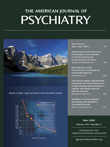New-Onset Tardive Dyskinesia in Patients With First-Episode Psychosis Receiving Risperidone or Haloperidol
To The Editor: Tardive dyskinesia associated with antipsychotics is an important treatment concern. A recent long-term trial provided a unique opportunity to study tardive dyskinesia in a double-blind evaluation of haloperidol and risperidone in first-episode psychosis (1) . The findings were consistent with previous reports, suggesting lower rates of dyskinesia with atypical antipsychotics compared to conventional agents (1 , 2) . However, the a priori definition of tardive dyskinesia is a threshold increase over baseline levels of dyskinesia. This did not distinguish between dyskinesia after withdrawal of prior antipsychotics from new-onset, possibly drug-induced, cases.
We recently defined criteria for tardive dyskinesia using the Extrapyramidal Symptom Rating Scale and based on parameters previously reported (3) . Probable tardive dyskinesia was defined as scores ≥2 (2 or 3) (mild) or ≥1 of 4 (moderate) or greater on any item on the dyskinesia subscale of the Extrapyramidal Symptom Rating Scale. New-onset tardive dyskinesia was identified when patients without baseline dyskinesia (all items: 0 or 1) met this definition at two more consecutive visits (≥4-week duration), with onset beyond week 4 of discontinuing an oral antipsychotic or beyond week 8 of discontinuing a depot antipsychotic (ruling out withdrawal from tardive dyskinesia [4] ). The first application of these Extrapyramidal Symptom Rating Scale criteria to a database was recently reported (3) .
We applied this method in a post hoc analysis of a study by Schooler et al. (1) . Extrapyramidal Symptom Rating Scale dyskinesia data were available for 458 patients; 444 were rated without baseline dyskinesia. Among these patients, 0.87% (2 of 229, 95% confidence interval [CI]=0.00–2.08) receiving risperidone and 2.33% (5 of 215, 95% CI=0.31–4.34) receiving haloperidol met criteria for new-onset tardive dyskinesia (p=0.27, Fisher’s exact test). Annualized rates were 0.72% and 1.87%, respectively. Mean modal doses were 3.4 mg/day (SD=1.8) and 3.2 mg/day (SD=1.7), respectively.
This finding is similar to prior reports for risperidone (4) and atypical antipsychotics (2) . The approximately 2% annual rate of tardive dyskinesia with haloperidol is lower than previously reported and can be explained by the low dose in this study. The lower incidence with risperidone versus haloperidol was not statistically significant owing to the small number of subjects but may be considered clinically relevant given the concerning nature of tardive dyskinesia. Schooler et al. (1) reported higher rates in both groups, at least partly because of methods that did not discriminate withdrawal or existing dyskinesia from newly emergent tardive dyskinesia. The research criteria reported in this letter are consistent with other published criteria for identifying new-onset tardive dyskinesia.
1. Schooler N, Rabinowitz J, Davidson M, Emsley R, Harvey PD, Kopala L, McGorry PD, Van Hove I, Eerdekens M, Swyzen W, De Smedt G, Early Psychosis Global Working Group: Risperidone and haloperidol in first-episode psychosis: a long-term randomized trial. Am J Psychiatry 2005; 162:947–953Google Scholar
2. Correll CU, Leucht S, Kane JM: Lower risk for tardive dyskinesia associated with second-generation antipsychotics: a systematic review of 1-year studies. Am J Psychiatry 2004; 161:414–425Google Scholar
3. Gharabawi GM, Bossie CA, Lasser RA, Turkoz I, Rodriguez S, Chouinard G: Abnormal Involuntary Movement Scale (AIMS) and Extrapyramidal Symptom Rating Scale (ESRS): cross-scale comparison in assessing tardive dyskinesia. Schizophr Res 2005; 77:119–128Google Scholar
4. Gharabawi GM, Bossie CA, Zhu Y, Mao L, Lasser RA: An assessment of emergent tardive dyskinesia and existing dyskinesia in patients receiving long-acting injectable risperidone: results from a long-term study. Schizophr Res 2005; 77:129–139Google Scholar



